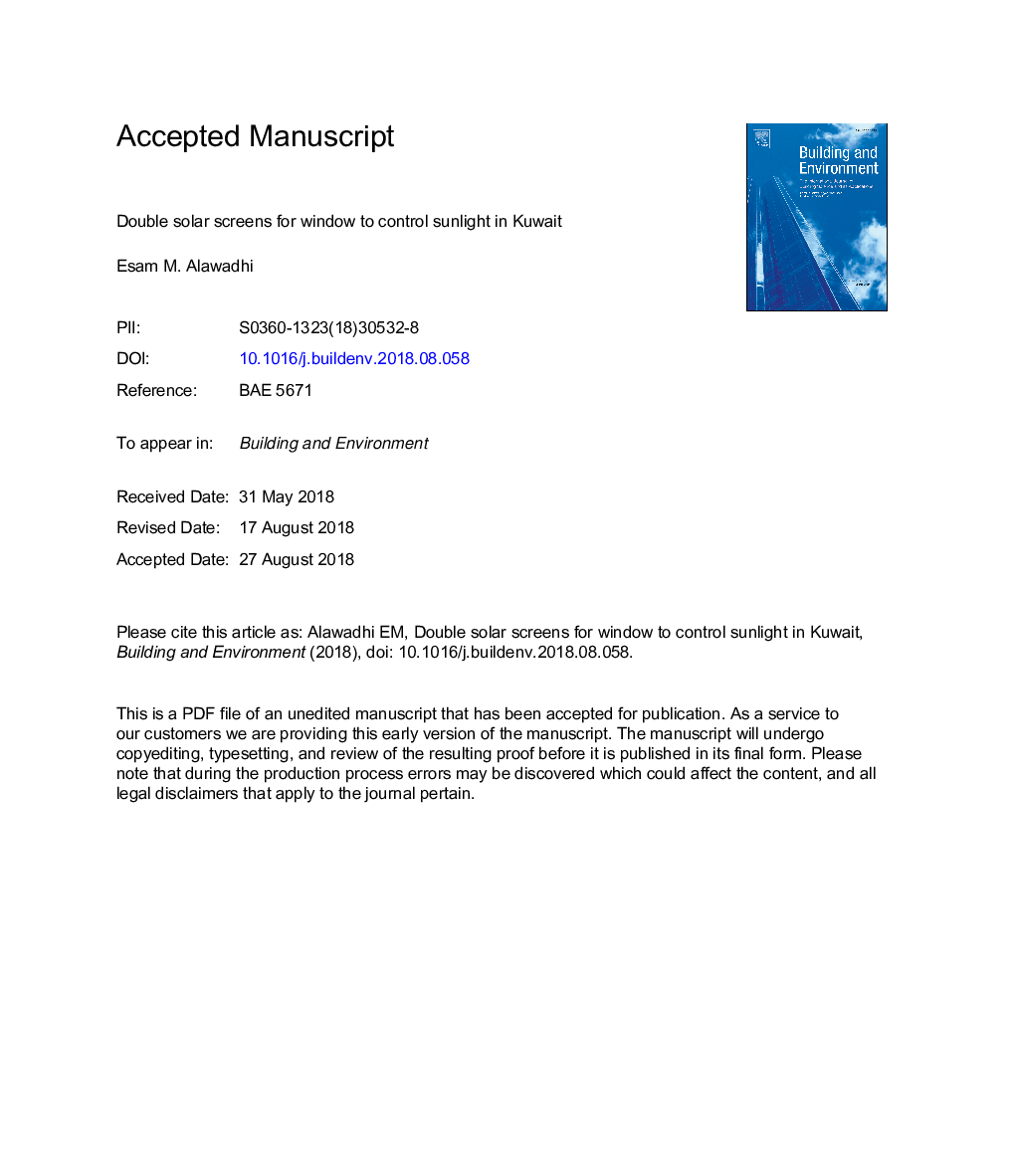| کد مقاله | کد نشریه | سال انتشار | مقاله انگلیسی | نسخه تمام متن |
|---|---|---|---|---|
| 11000961 | 1428348 | 2018 | 29 صفحه PDF | دانلود رایگان |
عنوان انگلیسی مقاله ISI
Double solar screens for window to control sunlight in Kuwait
ترجمه فارسی عنوان
دو صفحه نمایش خورشیدی برای پنجره برای کنترل نور خورشید در کویت
دانلود مقاله + سفارش ترجمه
دانلود مقاله ISI انگلیسی
رایگان برای ایرانیان
کلمات کلیدی
پنجره صفحه نمایش خورشیدی، سطح روشنایی، جریان دما، انرژی خورشیدی،
ترجمه چکیده
این پژوهش تجربی مفهومی از دو صفحه ی خورشیدی نصب شده در قسمت خارجی یک پنجره را بررسی می کند. هدف از صفحه نمایش های خورشیدی دوگانه کنترل مقدار نور خورشید وارد فضای داخلی برای مقابله با عوارض منفی نور خورشید است. دو صفحه نمایش سوراخ یک طرفه با سوراخ مربع در نظر گرفته شده و نسبت سوراخ شدن هر صفحه 25٪ است. روش های مختلف نصب دو صفحه با توجه به عدم تعادل سوراخ آنها در نظر گرفته شده است. برای مقاصد مقایسه، یک پنجره بدون صفحه ی خورشیدی و با یک صفحه ی خورشیدی تک در نظر گرفته شده است. اندازه گیری ها در اواسط ماه ژوئن انجام می شود و صفحه نمایش روی غرب نصب می شود. بدون صفحه نمایش خورشیدی، تنوع درخشندگی قابل توجهی در فضای داخلی وجود دارد و بین 200 تا 13810 لوکس متفاوت است. با استفاده از یک خورشید تنها سطح روشنایی داخلی 90٪ کاهش می یابد و جریان گرما از طریق پنجره به میزان 27.1٪ کاهش می یابد. اگر صفحه دوم خورشیدی نصب شده باشد، میزان روشنایی بین 175 تا 200 لیتر متغیر است و جریان گرما بین 36.1٪ تا 52.5٪ کاهش می یابد، بسته به ناهماهنگی سوراخ های صفحه نمایش. در شرایط روشنایی، نمایشگرهای خورشیدی با پایین حفره های ناهموار، بهترین عملکرد را نشان می دهند، در حالی که صفحه نمایش خورشیدی با حفره های راست ناهموار بالاترین میزان گرمای جریان را فراهم می کند. عملکرد کلی صفحه نمایش های دوگانه خورشیدی با سوراخ های ناهموار، به ترتیب به دلیل روشنایی و کاهش جریان گرما در پنجره است.
موضوعات مرتبط
مهندسی و علوم پایه
مهندسی انرژی
انرژی های تجدید پذیر، توسعه پایدار و محیط زیست
چکیده انگلیسی
This research experimentally investigates the concept of double solar screens installed on the external side of a window. The aim of the double solar screens is to control the amount of sunlight entering the indoor space to tackle the negative side effect of sunlight. Two identical perforated screens with square holes are considered, and the perforation ratio of each screen is 25%. Different installation arrangements of the two screens with respect to their holes' misalignment are considered. For comparison purposes, a window without a solar screen and with a single solar screen is considered in the study. The measurements are conducted in mid-June, and screens are installed on the West facing façade window. Without the solar screens, there is significant illuminance level diversity in the indoor space, and it varies between 200 and 13,810 Lux. With a single solar, the indoor illuminance level is decreased by 90%, and the heat flow through the window is decreased by 27.1%. If a second solar screen is installed, the illuminance level varies between 175 and 200 Lux, and the heat flow is reduced between 36.1% and 52.5%, depending on the misalignment of the screens holes. In term of illuminance, solar screens with down misaligned holes show the best performance, while the solar screens with right misaligned holes provide the highest heat flow reduction. The overall performance of double solar screens with down misaligned holes is the optimum in term of the illuminance and heat flow reduction through the window.
ناشر
Database: Elsevier - ScienceDirect (ساینس دایرکت)
Journal: Building and Environment - Volume 144, 15 October 2018, Pages 392-401
Journal: Building and Environment - Volume 144, 15 October 2018, Pages 392-401
نویسندگان
Esam M. Alawadhi,
